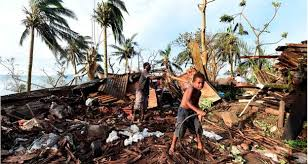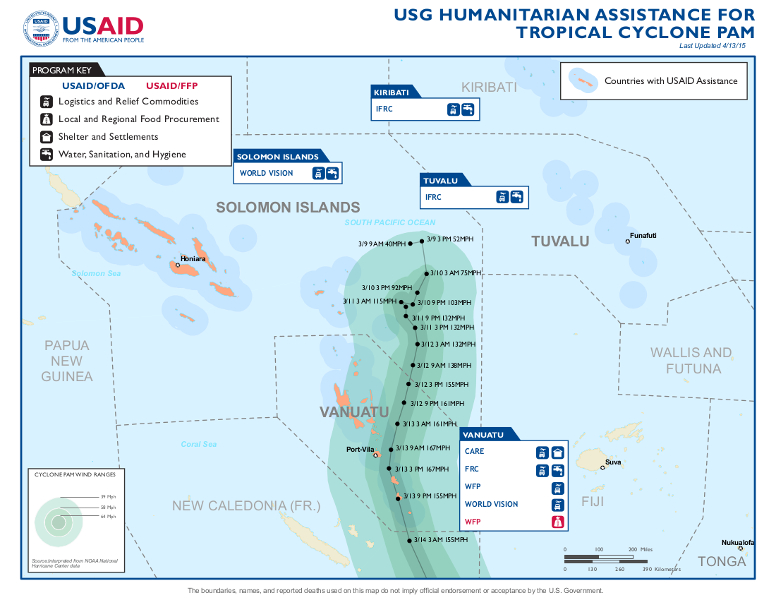Impact and Management of Cyclone Pam
Impact
When?
The storm developed in early March, making landfall between 13-14 March 2015.
Where?
The cyclone hit the islands of Kiribati, Tuvalu, the Solomon Islands and Vanuatu. It was in Vanuatu where the worst impacts were felt.
Why?
Pam started as two separate storms before combining and growing into a tropical cyclone. The storm gained energy from the warm waters of the South Pacific The flow of warm, rapidly rising air produced an area of extreme low pressure at the centre. The Coriolis effect will have also contributed to the spinning of the storm.
- Widespread destruction of fruits, vegetables, root crops and livestock occurred. The majority of fruit trees have been either destroyed, or completely stripped of all fruit.
- Seeds and farming equipment have been destroyed. Fishing boats and gear were also lost but to a much lesser extent.
- The brunt of the impact was on housing. In the most affected provinces by the cyclone, most households live in traditional houses (75% in Tafea), constructed of bamboo matted walls and Natangura (sago palm) thatched roofs. Most of these houses were damaged.
- Schools were all closed until 30 March. Extensive damage had been observed to school buildings. School fees for Vanuatu are hefty (5.4% of total household expenditure goes to education), particularly for larger households. Concern was expressed by teachers on the impact cyclone Pam may have on school enrolment, as parents may be unable to afford school fees.
- The death toll from Cyclone Pam is uncertain, with totals from the Vanuatu Government and United Nations differing. According to Vanuatu, 11 people lost their lives as a direct result of Pam. Four others died at Vila Central Hospital shortly after the storm’s passage, though these are considered indirectly related.
According to the United Nations, a total of 16 people were killed. In the immediate aftermath, media outlets indicated unconfirmed reports of 44 casualties in the many villages destroyed by the storm however, these claims were never substantiated.
- At least 132,000 people were affected by Tropical Cyclone Pam, of whom 54,000 were children.
Communication across the country was crippled, with only one cellular tower in Port Vila remaining operational. The power grid was devastated as well. Four days after the storm, nearly 60 of the nation’s inhabited islands remained cut-off from the outside world.
Management and Response
- Authorities did prepare for the cyclone.
- The track of the cyclone was monitored to identify areas that were likely to be hit. Plans were also made in case the storm changed direction.
- Cylclone warnings were issues in Torba, Sanma, Penama, Malampa, Shefa and Tafea provinces in Vanuatu.
- The government warned people of potential hazards, including torrential rainfall and flooding, including flash flooding that was likely over low-lying areas, river banks and near coastal areas. They also warned about landslides.
- Evacuation centres were identified across the country. Jotham Napat (chairman of Vanuatu’s National Disaster Management Committee), said potential evacuation centres were being identified across the country. “We are requesting our police officers to move into different communities to let them know they need to be evacuated to certain areas; we’ll be using mostly the churches and the public buildings.”
- Residents boarded up their windows and stockpiled food and water.
- Police sent market traders home to prepare.
- In some areas schools were ordered to close.
What were the responses?
The response to Tropical Cyclone Pam began immediately after the storm left Vanuatu’s borders. In the 12 months since the event, more than 50 organisations, both local and international, have worked together under the lead of the Vanuatu Government to ensure relief efforts are coordinated and aid is getting to those who need it most.
Water, sanitation and hygiene kits have been provided to families in evacuation centres. UNICEF has delivered some 2,800 water containers to Tanna, as well as purification tablets and soap. Although 1,400 shelter kits have arrived in-country, an estimated 12,000 kits and 24,000 tarpaulins are urgently required.
Initial agriculture damage estimates indicate significant losses to crops and livestock. Food security will be an issue so people can rebuild their lives.
- Emergency food aid for an estimated 19,000 households, based on the path of the cyclone.
- Initial agriculture damage estimates, from Port Vila, and aerial surveys of Tanna, Ambrym, Emae and Epi islands indicate significant losses to crops and livestock.
- UNICEF reports that 28 schools in Efate and six in Torba and Penama are being used as evacuation centres. There is an estimated 70,000 school-aged children, from early childhood through secondary school, affected.
- There is a need to set up temporary learning spaces as the majority of schools are expected to be affected – a high priority for both resumed learning but also to help with psycho-social healing and child protection.
On the one year anniversary of Cyclone Pam, aid organisations on the ground in Vanuatu continue to roll out drought assistance along with its post-cyclone response, even as other catastrophes strike the region.

